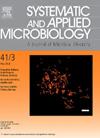Comparative genomics of Elusimicrobiaceae (phylum Elusimicrobiota) and description of the isolates Elusimicrobium simillimum sp. nov., Elusimicrobium posterum sp. nov., and Parelusimicrobium proximum gen. nov. sp. nov.
IF 4.2
2区 生物学
Q2 BIOTECHNOLOGY & APPLIED MICROBIOLOGY
引用次数: 0
Abstract
The tree of life comprises many deep-branching lineages with no or only very few cultured representatives. One such lineage is the phylum Elusimicrobiota, which contains only two described species and whose biology has been only poorly explored. We isolated three new species from this phylum from the intestinal tracts of cockroaches. Like their closest relative, Elusimicrobium minutum, the only member of the family Elusimicrobiaceae described to date, they are small, pleomorphic gram-negative rods characterized by a distinct cell cycle, and like all ultramicrobacteria, they pass through a 0.22-μm filter membrane. Physiological characterization of all isolates revealed that they are obligately anaerobic fermenters that lack catalase and cytochrome c oxidase activities but can remove oxygen from their environment in a non-respiratory manner. Their substrate range is limited to a few hexoses, such as d-glucose, d-galactose, and N-acetyl-d-glucosamine, which are fermented to lactate, acetate, ethanol, and hydrogen as major products. Comparative genome analysis, which included more than 100 MAGs of uncultured lineages of Elusimicrobiaceae, revealed the underlying metabolic pathways and outlined a new phylogenomic framework of the family. Based on phylogenomic, physiological, and morphological evidence, we describe the new isolates as Parelusimicrobium proximum gen. nov., sp. nov., Elusimicrobium posterum sp. nov., and Elusimicrobium simillimum sp. nov. under the rules of ICNP. Based on high-quality genomes of all uncultured representatives, we propose a comprehensive taxonomy of all lineages in the family under the rules of SeqCode, including the new genera Avelusimicrobium, Proelusimicrobium, and the candidate genus “Pseudelusimicrobium”.
Elusimicrobiaceae (phylum Elusimicrobiota) 的比较基因组学以及 Elusimicrobium simillimum sp.
生命之树包括许多深分支谱系,没有或只有很少的文化代表。其中一个谱系是微生物门,它只包含两个已被描述的物种,其生物学研究也很少。我们从蟑螂的肠道中分离出这个门的三个新种。与它们最近的亲戚Elusimicrobium minutum(迄今为止描述的Elusimicrobiaceae家族的唯一成员)一样,它们是小的、多形性的革兰氏阴性杆状体,具有独特的细胞周期,并且像所有超微生物一样,它们通过0.22 μm的过滤膜。所有菌株的生理特性表明它们是专性厌氧发酵剂,缺乏过氧化氢酶和细胞色素c氧化酶活性,但可以以非呼吸方式从其环境中去除氧气。它们的底物范围仅限于几种己糖,如d-葡萄糖、d-半乳糖和n -乙酰-d-氨基葡萄糖,这些己糖发酵后产生乳酸盐、乙酸盐、乙醇和氢作为主要产物。比较基因组分析,包括超过100个未培养的Elusimicrobiaceae谱系的MAGs,揭示了潜在的代谢途径,并概述了该家族的新系统基因组框架。根据系统基因组学、生理学和形态学证据,我们根据ICNP规则将新分离物描述为近邻异孢菌(Parelusimicrobium proximum gen. nov., sp. nov.)、后孢菌(Elusimicrobium posterum sp. nov.)和相似孢菌(Elusimicrobium similum sp. nov.)。基于所有未培养代表的高质量基因组,我们根据SeqCode规则对该科所有谱系进行了全面的分类,包括新属Avelusimicrobium, Proelusimicrobium和候选属Pseudelusimicrobium。
本文章由计算机程序翻译,如有差异,请以英文原文为准。
求助全文
约1分钟内获得全文
求助全文
来源期刊

Systematic and applied microbiology
生物-生物工程与应用微生物
CiteScore
7.50
自引率
5.90%
发文量
57
审稿时长
22 days
期刊介绍:
Systematic and Applied Microbiology deals with various aspects of microbial diversity and systematics of prokaryotes. It focuses on Bacteria and Archaea; eukaryotic microorganisms will only be considered in rare cases. The journal perceives a broad understanding of microbial diversity and encourages the submission of manuscripts from the following branches of microbiology:
 求助内容:
求助内容: 应助结果提醒方式:
应助结果提醒方式:


